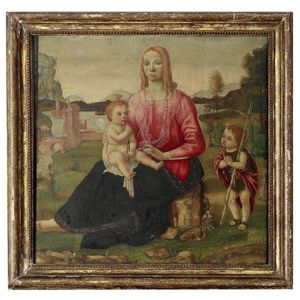Madonna and Child with St. John in Landscape
The Madonna and Child with Saint John in a landscape in the manner of Cosimo Rosselli, Florence, late 15th century, tempera on panel, seated on a rock in an idealistic wooded landscape with a bridge and town by a river beyond and distant Cliff and mountains, 67.5 x 66 cm (77.5 x 79 cm framed). Provenance: Wannenes Art Auctions, Genoa. Dipinti Antichi e del XIX Secolo, 28 March 2014, lot 1045, acquired from the above. Other Notes: The iconography of the Madonna and Child has been represented in a variety of formats which has evolved throughout the centuries. In the early middle Ages in the West, traditional representations of the Madonna and Child Jesus were adhered to - highly formulated, rigidly composed representations depicting the Regal Madonna enthroned with the Christ child and flanked by angels. However, in the 15th century depictions emerged of the smaller, seated Madonna appearing more maternal and less formally presented than in earlier representations. These works were generally intended for a small altar or domestic use and would often contain symbolism relating to the Passion of Christ. The babies modelled as Jesus became increasingly naturalistic, and a more maternal sweetness in Mary's demeanour becomes apparent, in the present work Mary's gaze is pensive but serene, as she contemplates her devotion to her Son, shadowed by his impending suffering. She wears a transparent silk veil and her signature blue mantle, indicating her purity, virginity and royalty. Blue was not a naturally occurring pigment and was thus considered a valuable hue reserved for only the most elevated subjects. One of the earliest blue pigments was made from lapis lazuli, a semi-precious stone once more costly than gold. The colour became associated with the Virgin Mary in the 5th century, when she was declared 'Queen of Heaven, Spiritual mother, and Intercessor' by the church. The red and pink hues of Mary's robe hold complex connotations, but in this instance likely symbolise motherhood, love, passion and devotion, this particular composition of the seated Madonna and Child - which includes St John the Baptist, Jesus' cousin and the protector and patron of Florence - was especially popular in 15th century Florence. St John's hands are joined in worship as the child Jesus blesses him with his right hand, holding a book with his left. St John the Baptist's biblical role is to prophesise the coming of the Messiah, and then to recognise Jesus in later life by baptising him. His reed cross symbolises a future of betrayal and death. The idealised bucolic landscape in the background composed of lakeside woodlands, an architectural structure and mountains on the horizon demonstrate the progress that was made in the Renaissance regarding systems of graphical perspective. It was not until the 14th century that narratives in painting were set against a landscape background, and by the 15th century this was the accepted form in European painting, this Madonna and Child is a graceful, untouched example of early Renaissance painting, full of the symbolism and devotion which would have inspired the 15th century Florentine Christian in their home.
You must be a subscriber, and be logged in to view price and dealer details.
Subscribe Now to view actual auction price for this item
When you subscribe, you have the option of setting the currency in which to display prices to $Au, $US, $NZ or Stg.
This item has been sold, and the description, image and price are for reference purposes only.
- Lapis Lazuli - Lapis lazuli is a semi-precious deep blue coloured stone, sometimes with gold inclusions, that has been used for thousands of years for jewellery, decorative items and decoration.
It is mined in Afghanistan, Siberia, Chile, USA and Burma. The mines in north-eastern Afghanistan are the largest source of lapis lazuli, and have been operating for over 6,000 years.
They were the source of the stone for the ancient Egyptian, Greek and Roman civilsations. - Manner of .... / Style of ..... - A cataloguing term where the item, in the opinion of the cataloguer is a work in the style of the artist, craftsman or designer, possibly of a later period.
This item has been included into following indexes:
- religious objects, Christian
- religious objects, furnishings - other 29
